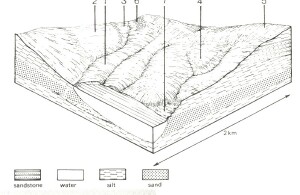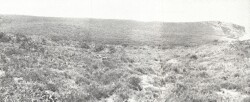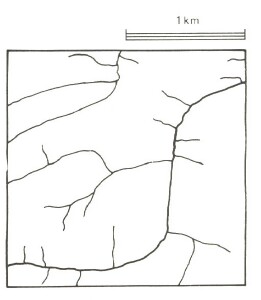Anglesea Land System
Download the pdf version of this document: Anglesea Land System (PDF - 716 KB)
To view the information, PDF requires the use of a PDF reader. This can be installed for free from the Adobe website (external link).
| Stretching inland from the coast between Bells Beach and Moggs Creek lies a dissected plain on Tertiary sediments. Long straight slopes emanate from spurs and ridges. The coastal margins are retreating an often abut the sea in steep cliffs or massive landslips and earthflows. The parent material is very variable, ranging from lateritized sediments on the ridges to relatively unweathered alluvium in the drainage lines. Thus the soils are particularly variable. In general, plant nutrient levels are low and surface horizons are weakly structured. Plant communities are mainly open forests les than 15 m in height; the height decreases towards the coast under the influence of salt-bearing winds. The area is highly regarded for its diversity of flora. Some parts have been cleared for agriculture. The main hazards to land use are gully erosion and sheet erosion. |  |
 Exposed coastal sites carry salt-pruned open scrubs that are sensitive to disturbance, and revegetation of eroded areas is difficult. |  |
Area: 74 km2 | Component and its proportion of land system | ||||||
1 25% | 2 5% | 3 10% | 4 30% | 5 25% | 6 2% | 7 3% | |
| CLIMATE Rainfall, mm | Annual: 600 –800, lowest January (35), highest August (80) | ||||||
| Temperature, 0oC | Annual: 14, lowest July (9), highest February (17) | ||||||
Temperature: less than 10oC (av.) July | |||||||
Precipitation: less than potential evapotranspiration mid October – early April | |||||||
| GEOLOGY Age, lithology | Highly variable Eocene sediment consisting mainly of unconsolidated clayey silt, sand | ||||||
| TOPOGRAPHY Landscape | Moderately dissected hills lying below and on the seaward side of the lateritic plateaux | ||||||
| Elevation, m | 0 - 195 | ||||||
| Local relief, m | 50 | ||||||
| Drainage pattern | Rectangular | ||||||
| Drainage density, km/km2 | 1.6 | ||||||
| Land form | Hill | ||||||
| Land form element | Exposed coastal slope | Slope, crest | Lower slop, drainage line | Middle slop | Upper slope, crest | Steep slop | Landslip |
| Slope (and range), % | 20 (5-45) | 2 (5-15) | 8 (1-15) | 15 (5-35) | 10(1-20) | 45 (25-55) | (5-90) |
| Slope shape | Linear/irregular | Linear | Concave | Convex | Convex | Linear | Irregular |
| NATIVE VEGETATION Structure | Open scrub | Woodland | Open forest | Open forest | Open forest | Open forest | Low woodland |
| Dominant species | E. obliqua, Casuarina stricta, E. sideroxylon | E. viminalis, E. radiata, E. baxteri | E. sideroxylon E. obliqua | E. sideroxylon E. obliqua | E. obliqua E. sideroxylon, E. baxteri | E. obliqua, E. baxteri, E. sideroxylon | E. sideroxylon E. obliqua Melaleuca lanceolata, Casuarina stricta |
| SOIL Parent material | Calcareous sand, clay silt, sand and gravel | Sand and gravel | Clay, silt and sand | Slay, silt and sand, sandstone | Deeply weathered clay, silt and sand | Lateritic ironstone, sandstone | Clay, silt and sand; some aeolian sand |
| Description | Variable sodic duplex soils | Grey sand soils, uniform texture | Yellow-brown sodic duplex soils, coarse structure | Yellow-brown duplex soils, coarse structure | Mottled yellow and red duplex soils | Stony red gradational soils | Variable sodic duplex soils |
| Surface texture | Sandy loam | Loamy sand | Fine sandy loam | Fine sandy loam | Sandy loam | Sandy loam | Sandy loam |
| Permeability | Moderate | Very high | Very low | Very low | Moderate | Very high | Moderate |
| Depth, m | >2 | >2 | >2 | >2 | >2 | 0.2 | >2 |
| LAND USE | Uncleared areas: Nature conservation; active and passive recreation; landscape conservation; gravel extraction Cleared areas: Beef cattle grazing on mainly unimproved pastures; residential; active recreation | ||||||
| SOIL DETERIORATION HAZARD Critical land features, processes, forms | Native vegetation is sensitive to salt pruning and disturbance. Highly dispersible soils on steep slopes are prone to sheet erosion, gully erosion and tunnel erosion | Very low inherent fertility and high permeability lead to nutrient decline. | Sodic, highly dispersible subsoils are prone to gully and tunnel erosion. | Highly dispersible soils are prone to gully and tunnel erosion. Weakly structured surface soils over slowly permeable subsoils on steep slopes are prone to sheet erosion. | Low inherent fertility, phosphorus fixation and leaching of permeable A horizons lead to nutrient decline. | Stony shallow soils with low organic content, weak structure and low water-holding capacity on steep slopes are prone to sheet erosion. | Native vegetation is sensitive to salt pruning and disturbance. Marine under-cutting of highly dispersible soils maintains active landslips and earth flows. |


